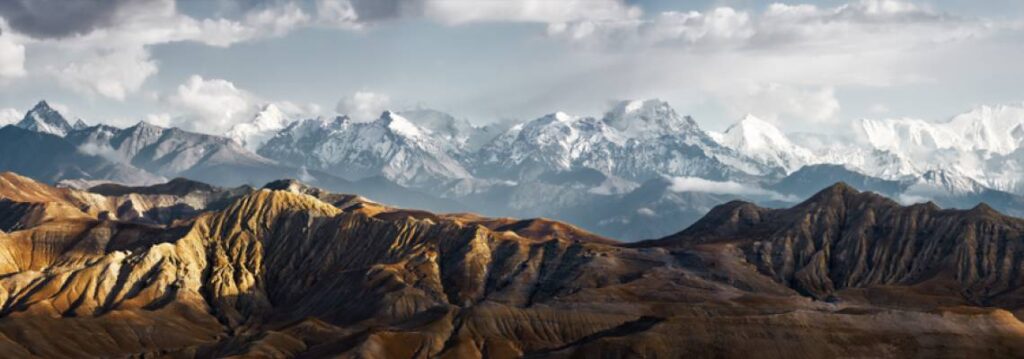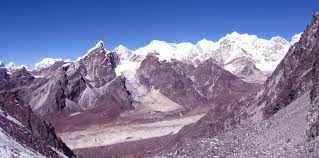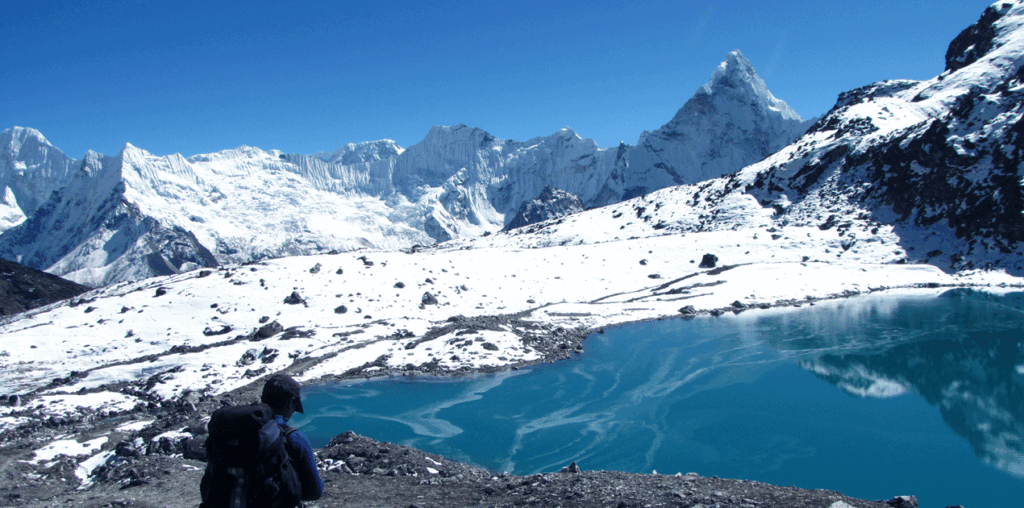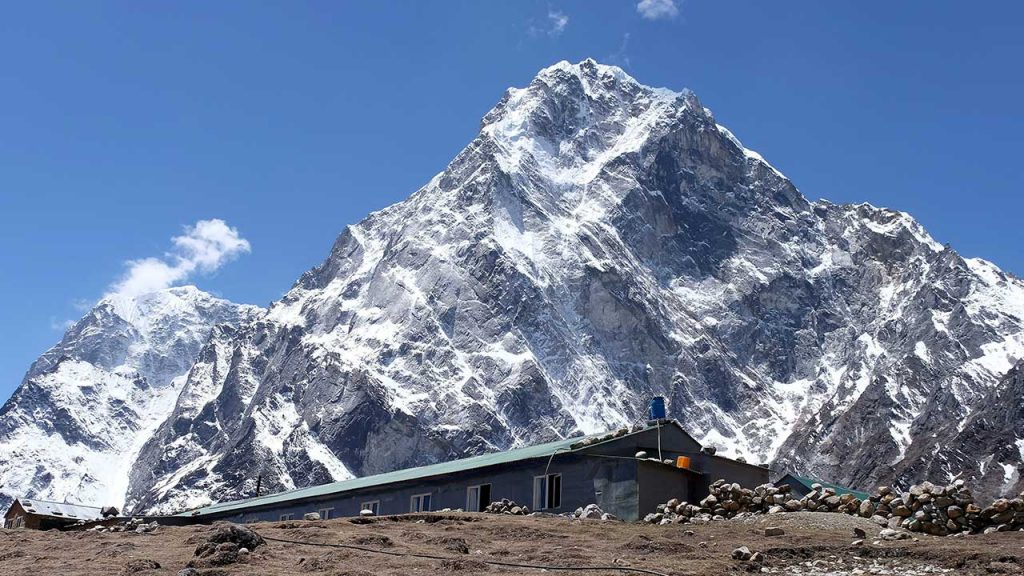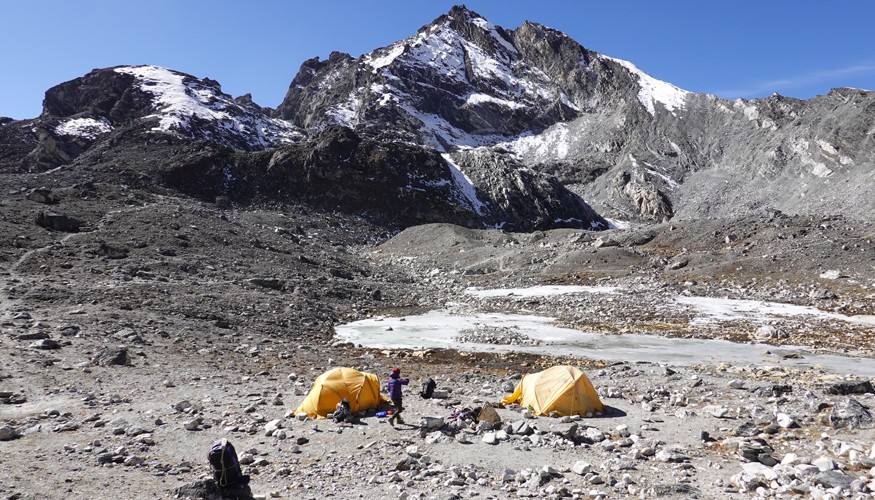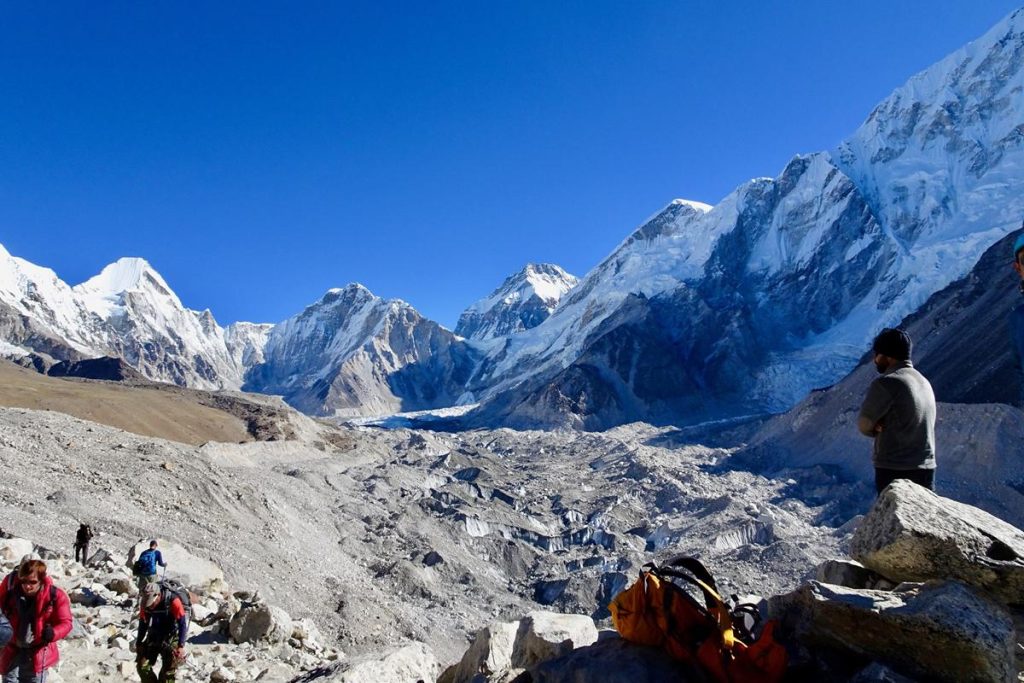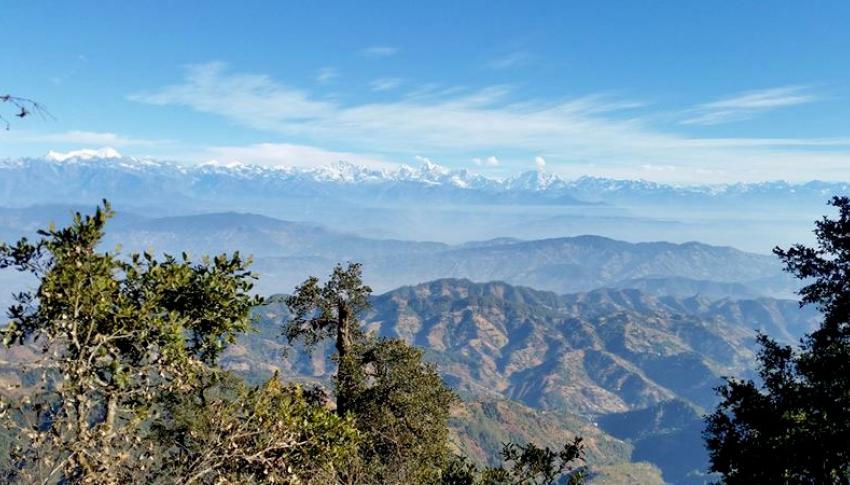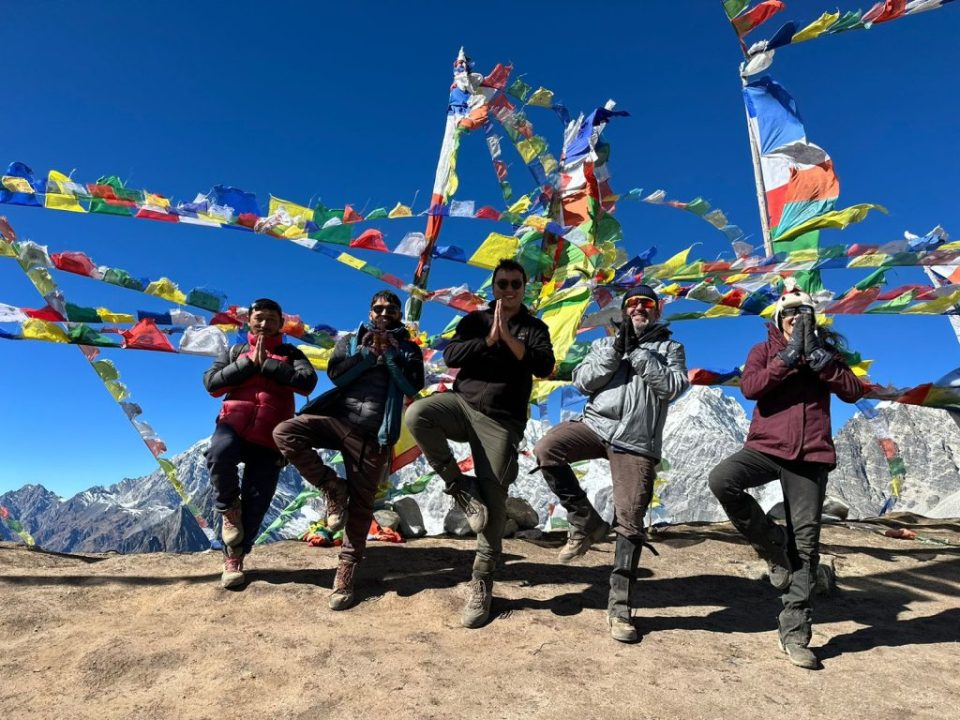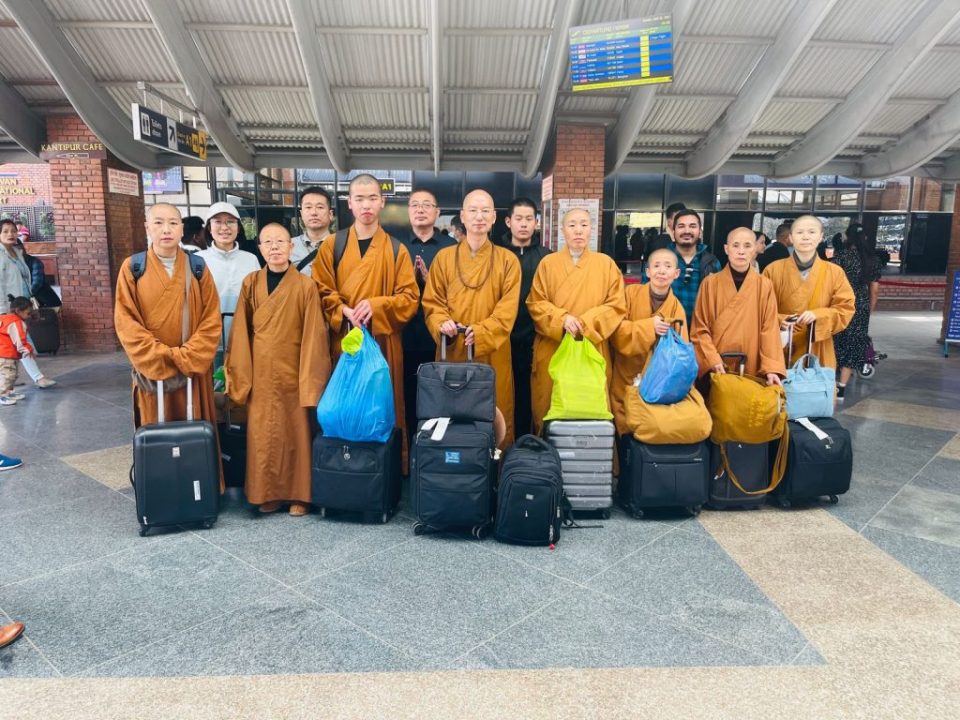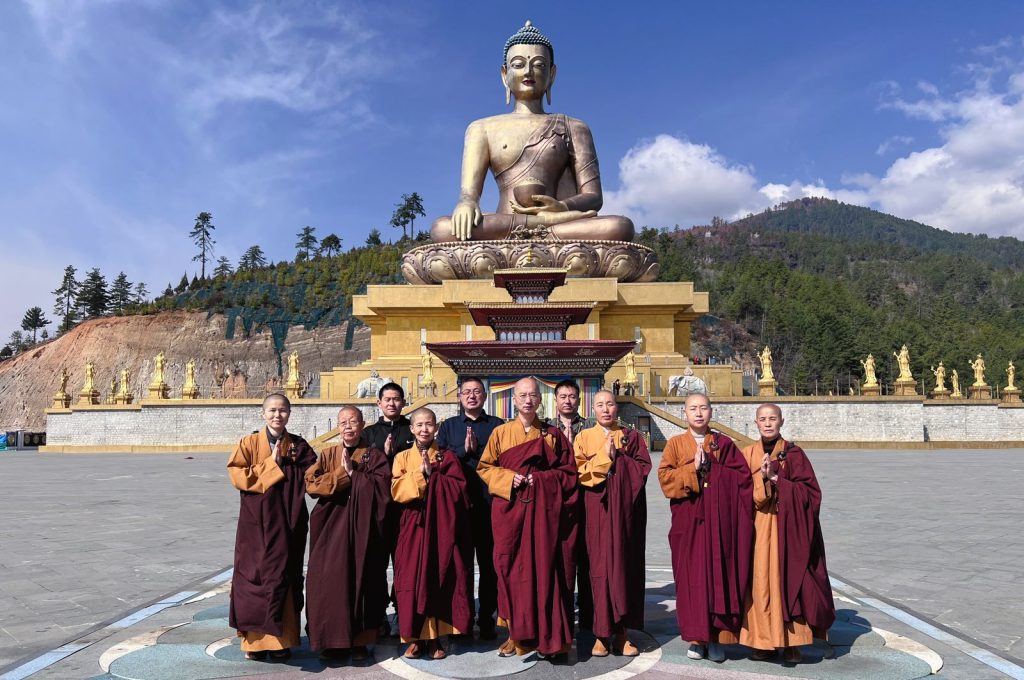Pokalde Peak Trek – 18 Days
Trip Introduction
Dolma Ri is another name for Pokalde Peak. It is a popular Nepal peak located 12 kilometers south-west of Mount Everest. It is one of the shortest and most easy trekking peaks. It is located at an elevation of 5,806 meters. It is one of the simplest climbs in Nepal. It is one of the best trekking and climbing combinations for first-timers. Mt. Everest, Nuptse, Ama Dablam, Lhotse, and many other peaks will be visible.
We will walk through the Khumbu region, the Sherpa people’s homeland. It’s the best of both worlds: trekking and climbing. We will walk on the world’s most popular trekking trails around the world’s tallest mountain for a breathtaking visit and once-in-a-lifetime cultural experience. The trail passes through wonderful forests, glacier moraines, mountains, and slopes. It also has a diverse range of flora and fauna, including musk deer, snow leopards, Himalayan Tahr, and red Pandas.
The 17-day trek begins with a flight to Lukla. The flight generally lasts 30 to 35 minutes. Lukla is the trek’s starting point. Lukla is a significant town in the Khumbu region. The road continues through the Imja Khola River from Namche Bazaar to the valley below Everest. The trail takes the traditional route to the destination, passing through Lobuche and Gorakshep. After reaching the EBC, we climb Kala Patthar to get a bird’s-eye view of Mt. Everest and the other Himalayan peaks. We will begin our ascent from the Lobuche village. We’ll make our way up to Pokalde Base Camp via Kongma La Pass. From there, we will summit to the peak and descend down to Chhukung. Further we will descend down to the Trek’s End Point Lukla.
Trip Facts
| Country | Nepal |
| Duration | 18 Days |
| Maximum Altitude | 5,806m/19,049ft |
| Region | Everest |
| Meals | Breakfast, Lunch, Dinner |
| Accommodation | Hotel, Lodge, Teahouses, Camp |
| Grade | Moderate |
| Best season | Mar, Apr, May, Sep, Oct, Nov |
Trip Highlights
- In the Khumbu region’s towns, learn about traditional high-Himalayan Sherpa culture.
- Personalize your Himalayan trekking and mountaineering adventure.
- Get your first glimpses of the sunrise over the majestic mountains, as well as the stunning sunset.
- A trek through the naturally unique Sagarmatha National Park with close-up views of 8000m, 7000m, and 6000m peaks.
- Enjoy the Everest region’s rich flora and fauna.
- Visit the Sherpa and Hilary Museums.
- Take in the greatest views of the Khumbu Icefall and Everest Base Camp.
- Visit the world-famous Tengboche Monastery in the Everest region.
- Summit Pokalde Peak at the Elevation of 5,806m.
- Pokalde Peak Climbing is non-technical and easy Climbing and is best for First-time Climbers.
Is this trek appropriate for you?
- This trek includes 15 days of strenuous climbing. You’ll be trekking for a minimum of 3 to a Maximum of 9 hours per day, reaching elevations of over 5000 meters at times. We cannot overestimate the importance of being in excellent physical shape and health, which requires training before your trip to ensure that you are properly prepared.
- This is the trek for you if you have previous rock climbing or wall climbing experience. It is recommended that you have prior experience with high-altitude trekking.
- The weather in the Himalayas can be unpredictable, and every year a large number of flights to or from Lukla are delayed or canceled because of weather conditions, so you should plan accordingly.
- The teahouses, or trekking lodges, where we stay on the trek are very basic, with just basic services. Hot water may not be accessible at all times and may be charged extra, as will access to electrical outlets for charging electronics. Wi-Fi is available in some areas, although the quality of the connection may be poor.
- The path twists and turns through challenging terrain. At 5,806 meters, you’ll reach the highest peak. Because of the weather, isolation, and high altitude of this walk, it’s critical to take it carefully and stay hydrated.
Itinerary
| Days | Activities | Durations |
| 1. | Arrival at Kathmandu (1400m/4,592ft) | |
| 2. | Fly to Lukla (2,840m/9,318ft) and trek to Phakding (2610m/8,563ft) | 3-4hrs |
| 3. | Trek from Phakding to Namche Bazaar (3440m/11,286ft) | 5-6hrs |
| 4. | Acclimatization day Namche Bazar | |
| 5. | Trek from Namche Bazaar to Tengboche (3870m/12,697ft) | 5-6hrs |
| 6. | Trek from Tengboche to Dingboche (4410m/14,469ft) | 5-6hrs |
| 7. | Trek from Dingboche to Lobuche (4900m/16,076ft) | 6-7hrs |
| 8. | Trek from Lobuche to Gorakshep (5,140m/16,864ft) and hike to EBC (5,365m/17,602ft) | 7-8hrs |
| 9. | Hike from Gorakshep to Kala Patthar (5,550m/18,2019ft) and trek to Lobuche (4900m/16,076ft) | 5-6hrs |
| 10. | Trek from Lobuche to Pokalde Base Camp (4,400m/14,435ft) via Kongma La Pass (5,545m/18,192ft) | 7-8hrs |
| 11. | Trek from Pokalde Base Camp to High Camp (5,000m/16,404ft) | 5-6hrs |
| 12. | Summit Day to Pokalde Peak (5,806m/19,048ft) and Back to Chhukung (4,730m/15,518ft) | 8-9hrs |
| 13. | Contingency Day | |
| 14. | Trek from Chhukung to Tengboche (3870m/12,697ft) | 6-7hrs |
| 15. | Trek from Tengboche to Namche Bazaar (3440m/11,286ft) | 5-6hrs |
| 16. | Trek from Namche Bazaar to Lukla (2,840m/9,318ft) | 6-7hrs |
| 17. | Fly from Lukla to Kathmandu | 35min |
| 18. | Departure |
Itinerary
Departure from : Kathmandu, Nepal
Arrival On : Kathmandu, Nepal
Day 1
Arrival in Kathmandu
Upon arrival at TIA. You will be greeted and transferred to the hotel by our representative. Check-in the hotel. Get Fresh up. In the evening our guide for the trek will visit you and he will give you a short briefing about your trek. Dinner and overnight at Kathmandu.
Day 2
Fly from Kathmandu to Lukla and trek to Phakding
After breakfast. Check out from the hotel and transfer to TIA for a flight to Lukla. The flight to Lukla from Kathmandu is just about 25min. The fly provides great views of Everest and its regions. On arrival to Lukla, we will meet and greet with our team and move towards Phakding. On the way to Phakding, we’ll get our Khumbu Rural Municipality Entrance permit from the Rural Municipality counter in the first village from Lukla. We will trek through the beautiful scenery of Khumbu valley with the smell of cherry blossom and rhododendrons, cross the suspension bridge over Dudh Koshi River. We will be walking for 3-4hrs to reach Phakding. Dinner and overnight stay at the lodge.
Day 3
Trek from Phakding to Namche Bazaar
After breakfast, we will trek to Namche Bazaar for around 4-5hrs. It takes 2hrs from Phakding to Monjo and at Monjo, we will get our Sagarmatha National Park permits check as we will be entering the UNESCO world heritage site i.e., Sagarmatha National Park. We then climb steeply to Namche, catching our first sight of Mt Everest from Topdanda. Ascending through the forest, crossing the suspension bridges including the famous Hillary Suspension bridge in Larcha Dovan over the Dudh Koshi River we reach Namche Bazaar. The largest trading village in Khumbu, the capital of Sherpa- Namche Bazaar, features a lively Saturday market. On arrival at Namche Bazaar. Check into the hotel. Dinner and overnight stay at hotel.
Day 4
Acclimatization at Namche Bazaar
This day we will take a rest at Namche Bazaar to make our body adapt to the environment and will not get altitude sickness in our further trek as we will be moving toward the higher altitude the next day. Have breakfast in the morning and explore around the Namche Bazaar. We can go for the morning hike to the Everest viewpoint over Namche to get the first look of Mt. Everest and Mt. Ama Dablam. Enjoy the amazing mountains views with sunrise. We can also set an acclimatization hike to the Sherpa Cultural Museum, Namche Monastery, National Park Office, Syangboche Airport, or to the Khumjung village. Explore around the café and restaurants, gear shops in Namche. Dinner and Overnight stay at Namche.
Day 5
Trek from Namche Bazaar to Tengboche
Early morning breakfast and we will head towards Tengboche. We will follow the trail up the valley’s slope, high above the Dudh Koshi River. We can see the stunning view of Mt. Ama Dablam, Thamserku, and Kangtega, Mt. Everest with river valley below. On the way, we can find some Himalayan Tahr and Himalayan Monals. After the walk of 3-4hrs will have our lunch at a local tea house or lodge. After lunch, we will trek for another 2-3hrs through the pine forest to reach Tengboche. Tengboche is known for its historical monastery, the largest in the Khumbu region, and is also the birthplace of mountaineer Tenzing Norgay Sherpa. In the evening, you can join the daily worship celebration by monks in the Tengboche monastery. Dinner and overnight at quite a monastic village of Tengboche.
Day 6
Trek from Tengboche to Dingboche
This day we will trek to Dingboche. After breakfast, we will walk past the village of Pangboche hiking within the woody forest. After the walk of around 3hrs, we will reach Syomare where we will have our lunch. Boosting our power, we head toward Dingboche for another 3-4hrs. Dinner and overnight at Dingboche.
Day 7
Trek from Dingboche to Lobuche
After the early breakfast, we will trek to Lobuche. Today we will walk for about 3-4hrs for our stay at Lobuche. It will be a little difficult to climb uphill for about 1hr but on reaching the top we will get all worth it, panoramic view of Taboche (6367m), Ama Dablam (6856m), and Nuptse (7861m) mountains. The rest of the trail is pretty flat. We will walk past some amazing mountain sceneries, boulders, passes. We will have our lunch at Thukla. Dinner and overnight at Lobuche.
Day 8
Trek from Lobuche to Gorakshep and hike to Everest Basecamp
After breakfast, we will start our trek early so that we can reach the Gorakshep on time and have sufficient time to hike to Everest base camp and return to Gorakshep. After the walk of 3-4hrs, we will reach Gorakshep and have our lunch. After lunch, we will hike to EBC. It is about 1.5hrs of an easy hike to EBC. You will get to see the huge, tallest mountain in the world, Mt. Everest (Mt. Chomolungma) right in front of your eye, and this feeling will be your once-in-a-lifetime best moment. After spending some time in EBC and clicking some photos we will return to Gorakshep. Dinner and overnight at Gorakshep.
Day 9
Hike from Gorakshep to Kala Patthar and trek to Lobuche
This day will have our early breakfast in the morning and go for a hike to Kala Patthar to see the 360-degree view of the Himalayan where the Kala Patthar will look like a black diamond peering over the shoulder of the other mountains. The rays of sunrise strike the mountain and make the mountain glow golden. After the sunrise view, we will come down to Gorakshep and have our lunch. After lunch, we will trek towards Lobuche. Dinner and overnight at Lobuche.
Day 10
Trek from Lobuche to Pokalde Base Camp via Kongma La Pass
We will depart for Pokalde Base Camp after breakfast. We’ll be walking for 7 to 8 hours. We’ll ascend to the Pokalde Base Camp via the Kongma La Pass. We’ll be walking down a rocky and steep trail. We’ll stop for lunch on the way. We’ll carefully make our way up to Pokalde base camp. We’ll set up camp and enjoy some warm beverages once we arrive at the base camp. Dinner and overnight at Pokalde Base Camp.
Day 11
Trek from Pokalde Base Camp to High Camp
We’ll leave for High Camp after breakfast. We’ll be walking for 5 to 6 hours. We’ll only be climbing 600 meters. We’ll walk along the rocky path. After we freshen up and eat lunch, you will have a training period during which your guide will teach you how to use climbing equipment such as an ice ax, jumar, and crampon, as well as some other basic skills. We will become familiar with the necessary equipment and learn basic rope skills. You’ll need to practice to get it right. Dinner and overnight at High Camp.
Day 12
Summit Day to Pokalde Peak and Back to Chhukung
After breakfast, we will depart for the summit of Pokalde Peak. We’ll be walking for 8 to 9 hours. Today, we must begin our day at a very early hour. To reach the top, we must properly equip ourselves and follow the guide steps. We’ll be walking on ice and snow. This ascent is more difficult than the ascent to Other Peak. We will arrive at the summit after 5 to 6 hours, where we will be able to admire the magnificent views of Mount Everest, Lhotse, Makalu, Cho Oyu, and Pumori Mountain ranges. We will take in the scenery for a while before rapping down to Chhukung through Kongma la Pass, where we will enjoy hot drinks and enjoy the achievement. Dinner and overnight at Chhukung.
Day 13
Contingency Day for Summit
An additional day in case severe weather prevents you from summiting on time. This day can also be used in the event of an emergency, such as canceled or missed flights, delays due to minor injuries or weather conditions, and so on. If you keep to your timetable and everything goes according to plan, you can spend the extra day exploring a Sherpa village along the way.
Day 14
Trek from Chhukung to Tengboche
We’ll leave for Tengboche after breakfast. We’ll be walking for 6 to 7 hours. We’ll make our way down to Tengboche. We’ll walk alongside the pine trees and Imja Khola. We will also pass through several Sherpa settlements such as Pheriche and Pangboche. With the wonderful scenery, we’ll stop for lunch on the way. We’ll continue walking toward Tengboche. Tengboche is famous for its historical monastery, the largest in the Khumbu region, as well as being the birthplace of mountaineer Tenzing Norgay Sherpa. In the evening, you can participate in the monks’ daily worship celebration at Tengboche monastery. Dinner and overnight in Tengboche, a monastic village.
Day 15
Trek from Tengboche to Namche Bazaar
We will depart for Namche Bazaar after breakfast. We’ll be walking for 5 to 6 hours. We’ll get there by ascending a suspension bridge. We’ll hike up the valley’s slope, high above the Dudh Koshi River. We’ll go for a walk in the National Park. We’ll stop for lunch on the way.
Further, we will walk toward Namche Bazaar. We reach Namche Bazaar. The largest trading village in Khumbu, the capital of Sherpa- Namche Bazaar, features a lively Saturday market. On arrival at Namche Bazaar. Check into the hotel. Dinner and overnight stay at hotel.
Day 16
Trek from Namche Bazaar to Lukla
After breakfast, we will walk through the same trail to reach Lukla. We make our way to the Hillary Suspension Bridge, passing through several local villages along the way. We will be hiking for 5-6 hours covering 18.5km. On our arrival in Lukla, check-in at the lodge where we will stay for the night. Take some rest and have a wonderful evening on the last day in the Khumbu region with our team. Dinner and overnight at Lukla.
Day 17
Fly from Lukla to Kathmandu
After breakfast. Check out from the hotel and fly back to Kathmandu. On arrival, our representative will pick you up and transfer you to the hotel. Check into the hotel. Free for the day. You can stroll around the Kathmandu valley and have a night walk around the street of Thamel. Overnight at Kathmandu.
Day 18
Departure
The 16-day journey has concluded. Today is your last day in Kathmandu. Our representative will have a short discussion on the trip and take your feedback after a hearty breakfast. Following this session, he will drive you to the airport in our private transportation 3 hours before your trip.
Route Map
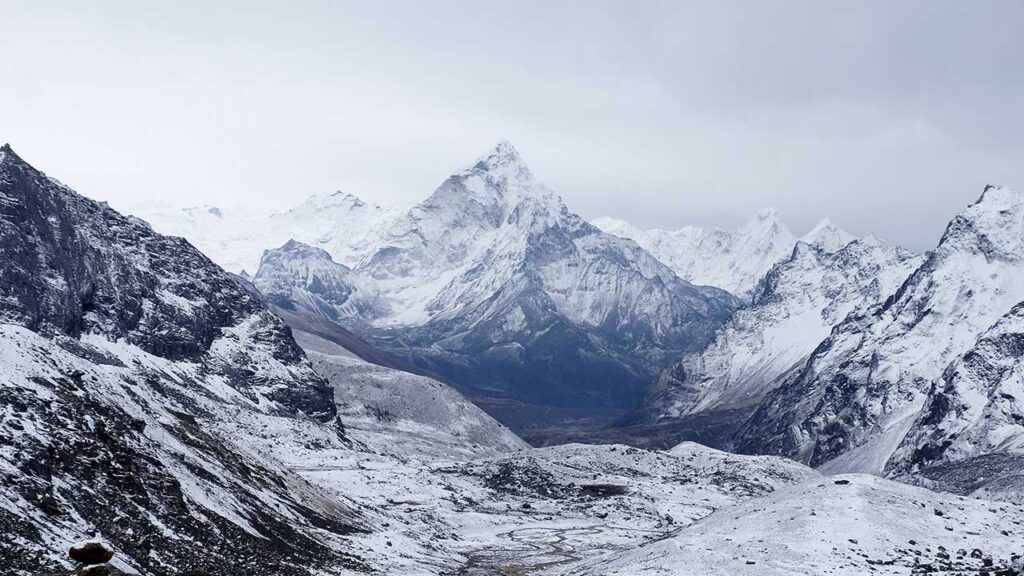
Altitude Map
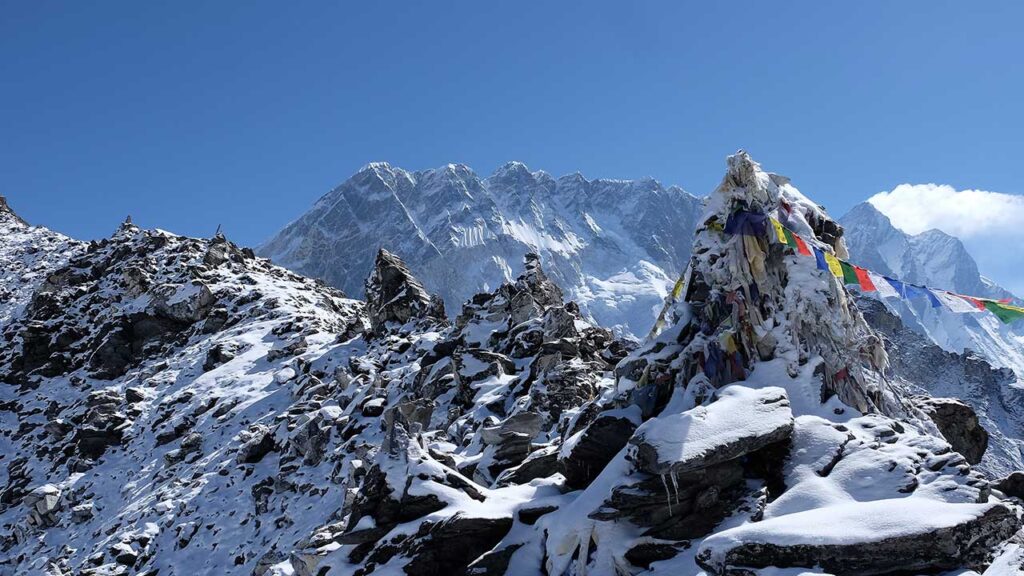
What's Included
- Arrival & Departure: Airport – Hotel transfer – Airport (Pick Up and Drop).
- Hotel Accommodation in Kathmandu: 2nights at Star categories hotel on twin sharing on BB basis.
- Welcome Dinner and farewell dinner at Nepali culture restaurant in Kathmandu.
- Food & Lodging: 3 meals a day (Breakfast, Lunch, Dinner) along with accessible accommodation sharing at Hotel/Lodge/Teahouse/Camp during the trek.
- Permit: All necessary paper works: Sagarmatha National Park permit, Khumbu Rural Municipality entry fee, and NMA Pokalde Peak Climbing Permit.
- All government and local taxes if necessary.
- Trekking Map.
- Member transportation: – Air Transportation: (Domestic Flight) Fly from Kathmandu – Lukla and while returning Lukla.
- Drinking water: 2 liters of boiled water to carry on thermos per day per member.
- Guide: Government licensed Guide (English speaking) during the trek.
- Porter: Porters (2 trekkers: 1 porter) up to 15kg during the trek.
- Insurance: Insurance for all involved Nepalese staff during the trek.
- Comprehensive Medical kit.
What's Not Included
- Air Fare: International flight airfare (from and to Kathmandu).
- Nepal entry visa fee.
- Extra night in Kathmandu: Extra nights’ expenses in Kathmandu. In case of early arrival or late departure, early return from Trekking (due to any reason) than the scheduled itinerary.
- Personal Insurance: Travel and high-altitude insurance. *Mandatory
- Personal Expenses: Telephone calls, Internet, Toiletries, battery recharge, hot shower, laundry, soft drinks, beer, and any alcoholic beverages.
- Personal Equipment: Clothing, Packing Items or Bags, Personal Medical Kit, Personal Trekking equipment.
- Rescue Evacuation: Medical and emergency rescue evacuation costs if required. (Rescue, Repatriation, Helicopter, Medication, Medical Tests and Hospitalization costs).
Equipment List
What to bring ?
General
Tailor Your Holiday
Lorem ipsum dolor sit amet, consectetur adipisicing elit, sed do eiusmod tempor incididunt ut labore et dolore magna aliqua. Ut enim ad minim veniam, quis nostrud
Fixed Departure
Why Travel With Us?
Secure Online Payment, No Credit Card Fee
Travel with Locals. Support Locals
Lifetime Deposit
Private & Tailor-Made Trips
24/7 International Support
Support Local Communities & Donate to Charity
All Inclusive Price
Secure Online Payment, No Credit Card Fee
The ideal season to travel
Spring
March: The month of March is ideal for trekking and admiring the spectacular mountain peaks. The Everest region trekking trail will be crowded with hikers beginning in March. In the Everest region, the spring season begins in March, the month of the Rhododendron. Trekking in March will provide you with the most memorable experiences in a pleasant and mild climate. At lower altitudes, the weather is not particularly hot, and at higher altitudes, it is not particularly cold. The views of the mountains are spectacular, and the trail is excellent. Nature can be experienced at its most beautiful.
April: April is the beginning of spring in Nepal, and the weather is ideal for trekking to Everest Region. The views are bright and clear at this time of year, and everyone enjoys spring. The surroundings are vibrant and colorful, with rhododendrons in bloom. It is the best time of year to see various bird and butterfly species. During your April trip to Everest Region, the weather is completely in your favor. The moderate heat of the sun, combined with the lack of wind, makes it ideal for trekking. Furthermore, the amount of rain and snow is insignificant.
May: May, the final month of the spring season in Nepal, is much hotter. Everest Region trek in May has the highest temperature of the year. Temperature and weather will vary depending on the altitude throughout the trek. During the day, the weather in the lower sections will be extremely hot. The nights, on the other hand, are tolerable.
Summer
June: June is the coldest time of the summer and has the least amount of rainfall. The month of June is the offseason and therefore less popular for trekking. In the region, June marks the start of the wet monsoon season. The weather is slightly humid, and you can enjoy nature while it is wet and cool. If you enjoy the rain, rainbows, and less crowded trails, this is the month for you. During this month, the air begins to become humid due to continuous rain.
July: Trekking in Nepal in July isn’t always joyful because the heavy rains can block your view of the beautiful mountains you’ll pass through. In July, you will notice that the temperature is not as chilly in the Everest Region. As the rain washes away the dust and pollution, the environment opens up and becomes very fresh, and you will be able to enjoy nature despite the chilly weather.
August: In the Everest Region, August is the off-season for trekking. In August, the monsoon season produces strong rains, especially in lower places. Due to weather-related concerns, most hikers avoid this month. The summer monsoon season comes to an end in August. It rains regularly, and you may feel a little chilly as a result. You should also be cautious because the trails are slippery and the possibility of landslides and avalanches is considerable.
Autumn
September: The monsoon season finishes in September, marking the start of the fall season. The optimum time to trek to Everest Region is in September. The weather and temperature for the Everest Region Trek are ideal. The temperature is pleasant during the day, but it is extremely chilly at night.
October: October is the month that falls between September and November. As a result, it keeps both monsoon rain and winter’s biting cold at distance. The weather is warm and pleasant in October, with clear skies and fresh air. The nights, on the other hand, are a little chilly, with a brisk breeze coming from the campsite. Throughout October, the weather is pleasant, allowing people to enjoy an unobstructed view of the snow-capped peaks. They can also visit bright valleys and interesting scenery of various colors.
November: The last declared peak season for trekking in Nepal is November. Bright, sunny days and beautiful skies characterize November. On the treks, these provide breathtaking, crystal-clear vistas of the mountains. The days are bright and sunny in November. The sky is clear, with perhaps a few stray clouds possible.
Winter
December: In the Everest Region, December is a rather dry month. It receives fewer than 25 millimeters of rain every year. The Everest Region is in the shadow of the Himalayas. As a result, December has a lower chance of rain. It is also possible to walk the Everest Region Trek in December. In December, hikers will get a unique perspective of the region.
January: In Nepal, January is in the midst of winter. The higher elevation receives moderate snowfall, whereas the lower elevation is ideal for trekking. During the day, you will feel warm, but as night falls, you will feel cold. In January, these areas receive little to no rainfall. As a result, the skies remain clear and the surroundings appear even sharper. The trails will be covered in snow, so you may need crampons to cross the pass.
February: The Everest Region trek in February is an escape from the hustle and bustle of everyday life to a place where all you can see are mountains and scenery. It’s peaceful because February is the coldest month of the year. Most people dislike trekking in the winter because they believe it is extremely difficult.
Flight to Lukla
- Almost every trip begins with a flight from Kathmandu to Tenzing Hillary Airport in Lukla, a small single-landing runway airport high in the Himalayas. As it is the easiest way for your trek to Pokalde Peak.
- Lukla Airport is also known as the most dangerous airport in the world. This airport, which is only open when the weather is calm and visibility is excellent.
- It’s impossible to say whether or not your Lukla flight will be canceled. If this occurs, your trip may be extended by one or two days. So, plan and add days to your itinerary to ensure you don’t miss your international flight.
- Flights to and from Lukla are currently operated from Manthali Airport in Ramechhap rush hours at Kathmandu Airport during the high season (spring and autumn). Kathmandu is 132 kilometers (4 hours and 30 minutes) away.
- Helicopters have a little more flexibility when it comes to arriving at Lukla, and can frequently make the flight in weather or visibility that a small plane would not be able to make. It is sometimes doable to switch your flight to a helicopter, but this can be expensive and there is no guarantee that you will arrive on time.
Altitude sickness
Altitude sickness is a sneaky monster that may attack even the fittest trekkers. These demands do everything in your power to prepare for altitude trekking and take things carefully throughout your journey. With increasing altitude, the amount of available oxygen decreases, which is the primary cause of high-altitude sickness.
The Pokalde Peak climbing is a high-altitude trek that needs proper acclimatization. Your body requires time to adjust to thin air, so start at a lower altitude and work your way up. Some of the symptoms of Altitude sickness are:
Early symptoms of altitude sickness
- Increased breathing.
- Increased urination.
- Headache and Restless sleep.
- Periodic breathing at night as a result of altitude.
Later symptoms
- Shortness of breath.
- Extreme fatigue.
- Respiratory failure.
- Cerebral edema.
Certain care should be made to ensure that the situation does not worsen. However, if the symptoms worsen, you may need to return to a lower height and seek medical help. There are, however, several other precautions you may take while trekking to lessen your risk of altitude sickness.
- Trekkers can change their bodies by slowly and gradually climbing, as our bodies require time to adjust to the oxygen level. At least one day of acclimatization rest is required for high altitude trekking, and you should go as high as possible before returning to a lower height for the night.
- You should do various strength training exercises such as running, cycling, jogging, push-ups, and going to the gym to acquire strength and stamina for your adventure.
- As the air gets increasingly thin, an increase in elevation reduces oxygen levels, and in the Everest region trek, an increase in altitude also means less vegetation. The consumption of alcoholic beverages, cigarettes, and tobacco decreases the body’s water content.
- The greatest remedy is to stay hydrated at all times. On your walk, instead of drinking cooled water, drink warm water.
- Diamox is the most effective altitude sickness medication; thus, you should bring a subscription with you on the trek. However, you should consult with your physician to see whether it is advantageous.
Things to know before trekking to Pokalde Peak.
Drinking-Water
Especially for trekkers, it is very necessary to hydrate your body at a higher altitude than in lower elevations to avoid dehydration and altitude sickness. Lack of fluid can be the main hindrance during this peak climbing journey. You should hydrate your body with at least 3-4 liters of water daily (Tea, soup, or normal drinking water).
Throughout the journey, you will come across many taps and river water resources but is not safe to drink without purifying them. Besides this, the only other place to find drinking water is lodges and teahouses. You can buy the plastic bottle water in the teahouses but get expensive as you climb to the higher altitude, and it pollutes the local ecosystem.
Every day, carry enough water for the day before beginning the trek because in someplace you won’t find any water resources on the trail i.e., Lobuche to Pokalde Base camp via. Kongma La Pass. In and beyond the base camp there are no water resources. So that, from the base camp you have to melt the snow for water and treat it to make it drinkable. But not to worry, if you are traveling from any agency like us, you’ll be provided hot water 2-3 liter per day. Therefore, we recommend you use a Reusable water bottle or water pouch favorable for both hot and cold water.
During this journey, you may have to pay from 1$ to 4$ for a sealed bottle of water. Here are some ways that you can use to make the water drinkable.
- Boiled water
Boiling water is the best way to purify the water. As we are climbing to a higher altitude you need to boil the water for about 3-minute and season it with a pinch of salt before drinking. You can get free cold water in the teahouse but for boiled water, it cost around 1-2$ per liter and 3$- 5$ for a large pot.
- Purification tablets or electrolyte powder.
Purification tablets like chlorine or iodine tablets are commonly used tablets by trekkers to disinfect the water. 1 tablet is enough for a liter of water. It takes around 30 min for the tablets to dissolve and become drinkable. Water, purified by tablets may leave a taste in your mouth.
Electrolyte powder is another option. Electrolyte powder is a better way to purify water than tablets because electrolyte powder contains minerals such as salt, Potassium, Magnesium, which are important for your body during the trek.
- UV Light water purifier/ SteriPEN.
It is a simple, effective, economic, and environment-friendly way to purify water. It kills the bacteria and virus within 10 sec by exposing them to ultraviolet light using Steripen, without changing the flavor of the water. This is a highly recommended method of purifying water (a one-time investment).
Electricity and Internet facility at Everest region.
Electricity facility.
Despite the challenging geography, weather conditions of the Everest region, you won’t be in darkness during the journey to Pokalde Peak. The whole Everest region is either powered by Hydroelectricity or Solar panel/ battery.
The lower area of the Everest region (Lukla, Phakding, Monjo, Namche Bazaar) is powered by local hydroelectricity so enjoy free electricity and internet service and there will be a charging socket in your hotel/lodge’s rooms. However, the people in the Upper area of the Everest region (Tengboche, Dingboche, Lobuche, Pokalde Base camp) relies on Solar panel or solar power battery for electricity that is enough to light the bulbs and charge small devices. There will be no charging socket in your room. There is a commonplace for charging usually in the dining area. You might be able to charge a normal mobile set, camera battery, and power bank from the solar power battery/generator by paying extra. Solar power might harm your device, so charge it at your own risk. As a result, it is recommended that you bring a power bank and spare camera batteries that will last the duration of your trek.
Charging a mobile phone cost 1.5$- 5$ per hour (from Dingboche onward)
Internet Facility and Service
Internet and network facility is needed to contact your family, friends, employee, to post updates and upload photos during the trek.
Everest link has been providing an internet facility throughout the Everest region.
You can purchase an Everest Link WI-FI card at the lodges/teahouse/guesthouses and use the Everest Link hotspots to connect to the internet anywhere on the path within Everest Region.
Cost of Everest Link WI-FI card:
-10GB= NRP 2000/ 17$
-20GB= NRP 3000/ 25$
(Valid for 30 days)
Both NTC and NCell network is available in the Everest region. You will be connected until you are within the coverage of the network signal. You can buy the NCell or NTC sim card from the stores in Kathmandu for 1USD. By taking data packages you can use the internet service up to Pokalde Peak Base Camp, only when the mobile network catches a signal. It is not guaranteed that your mobile network will have a signal all the time. A satellite phone is best for calls.
NTC cellular service is highly preferred over NCell because it provides good service and signals connectivity throughout the Everest region, in comparison to NCell.
| Buy NTC data package
Dial*1415# |
Cost of data package in NTC:
-14GB=7$ (Valid up to 28days -30GB=15$ (Valid up to 90 days) |
Check balance
Dial *1415# |
| Buy NCell data package
Dial *17123# and select. |
Cost of data package in NCell:
-15GB=10$ -25GB= 12$ (Valid up to 30 days) |
Check balance
Dial*101# |
Document needed to buy a sim card.
For foreigner = 1 passport size photo, Passport photocopy, or valid identity card.
For Nepali = 1 Passport size Photo, Photocopy of Citizenship.
Some useful tips to reduce the use of electricity.
- Extra batteries for the camera.
- Power bank with 5000-10000mAh.
- The solar charger and solar lamp (LuminAID Lamp).
- If possible, less usage of a device with low brightness, GPS, and WI-FI off.
Essential Backpack items for Pokalde Peak Climbing.
The bag of a trekker also reveals their climbing level of experience. A good trekker should be a smart backpacker. You should be pre-prepared for the things that you need in the journey.
Here are some of the things that you need to take with you for the journey.
Travel documents
- Airline tickets with the itinerary.
- Travel insurance policy documents.
- Valid passport.
- Copies of passport.
- Passport-sized photos.
- Nepalese cash.
- Travel permits.
Clothing
- A pair of waterproof trekking shoes or hiking boots.
- A pair of flip flop slippers or running shoes.
- A pair of mountaineering boots for climbing.
- 2-3 sets of thermals (leggings and tops)
- Pairs of hiking long sleeve shirts or tops.
- Pairs of trekking shorts and down pants.
- Fleece jumpers or a set of tracksuits.
- Good quality windproof down jacket.
- Lightweight waterproof jacket with large hood and pants.
- Insulated hard-shell jacket.
- Neck gaiter, leg warmer, and packet of pocket hand warmers.
- 5-6 pairs of quick-dry wool socks/liner socks, underwear, sports bra.
- Pair of inner and outer gloves.
- Knitted Hat, sun cap, beanie, or bandana.
- Glacier Sunglasses/ eyeshade for trekking and Full coverage eyewear for climbing (Eye and nose).
Trekking equipment
- Waterproof trekking bag of 40-50liter and Rucksack of duffel bag (if your backpack is not enough for all your item and need a potter).
- Reusable water bottle (both hot and cold) of at least 2-2.5litre.
- A sleeping bag and sleeping bag liner.
- Trekking stick/ poles.
- Pair of ice crampons (If trekking in winter).
- Route map to Pokalde Peak (Everest Region).
- LED Headtorch or solar lamp (LuminAID lamp).
- Stuff sacks, plastic bags.
- Plug adapter, Charging appliances, Power bank, Batteries.
- Pocket knife.
- Travel Wallet.
Peak Climbing equipment
- Ice Axe.
- Pair of ice/mountaineering crampons.
- Screw gate Carabiners (2lock, 2 unlock).
- Ascender (jumar)and Descender (figure of 8).
- Plastic mountaineering boots.
- Snow bar.
- Climbing Rope.
- Ice hammer.
- Ice screw.
Toiletries
- Rolls of Toilet paper, wet wipes, and tissue.
- Medium-sized quick-drying towel.
- Toothbrush and toothpaste.
- Hand sanitizer.
- Sunscreen, lip balm, body lotions.
- Portable mirror.
- Shampoo and soap.
Personal First Aid Kit
- Antibiotics
- Painkillers, Paracetamol, ibuprofen, aspirin, Nicole
- Sanitary pads
- Anti-inflammatory spray.
- Anti-Nausea tablets.
- Anti-diarrhea pills or power.
- Altitude sickness tablets.
- Water purifying tablets or electrolyte powder.
- Mosquito and Insect Repellent.
- Salt or anti-leech oil (If traveling in the rainy season, July- Aug)
- Earplugs
You can buy or hire trekking/climbing clothes and equipment in Kathmandu. If you are buying it, you have to allow an extra day for shopping; however, if you are hiring it, you must inform us in advance so that we can arrange it before you arrive in Kathmandu. This way you can reduce the weight of your luggage and save time and money.
Branded trekking/climbing clothes and equipment are available around the Thamel area at a reasonable price.
Note– Kathmandu- Lukla flight has a luggage allowance of 15 – 20 kg per person. For extra baggage, they charge 2$ – 3$ per kg. So, you can wear your trekking boots and jacket to reduce the weight. Have a hand carry bag for your passport, money, medicine, and pair of clothing. You can leave some unnecessary items in the hotel in Kathmandu also.
Accommodation, Meal, and Transportation
Accommodation
We will accommodate in star hotel during our stay in Kathmandu. In Lukla, Namche Bazaar, and Tengboche we will stay in lodges. For the rest of the stop, we stay at teahouses or camps.
Meal
During the trek, we will provide you three-time meals. You can choose from the given menu.
Breakfast– French toast, Cornflakes, Cereal, Pancakes, Bread butter, Roti- Tarkari, Eggs, Oatmeal, Porridge, Tea, etc.
Lunch– Dal Bhat (Rice, vegetable curry, meat curry, Lentils, Tomato Chutney, Salad, Papad) Vegetable noodle soup, Chicken noodles soup, Garlic soup, Broths, Fried noodles, Fried rice, Thukpa, Fried potato, Mo: Mo, etc.
Dinner– Dal Bhat (Rice, vegetable curry, meat curry, Lentils, Tomato Chutney, Salad, Papad) Vegetable noodle soup, Chicken noodles soup, Garlic soup, Broths, Fried noodles, Fried rice, Thukpa, Fried potato, Mo: Mo, etc.
Besides these, there are a variety of other options of food. You can buy it from your pocket.
Transportation
By Bus- From Kathmandu airport to hotel at Kathmandu and vice-versa.
By Air- Flight to Nepal. Flight from Kathmandu to Lukla and back.
Guide and Staff Arrangements
Throughout the trek, all your activities will be handled by our well-qualified and professional staff. We will do all the escorting. We are providing you with a highly experienced and licensed local Sherpa guide with fluent English speaking and has excellent communication skills. We will accompany you from Kathmandu and guide you throughout your Pokalde peak climbing journey. Each group of 4-5 trekkers will be assigned an assistant guide, as well as a porter for two trekkers (2*15kg =30kg). If your luggage weighs more than 15kg you will be provided a porter individually but you will be charged for 2 people.
All our lead guides, assistant guides, and potters are well professional and experienced. So, we hope for your respect and cooperation with us throughout the trek.
A typical day on the Pokalde Peak trek.
Every day will begin with the ringing of your alarm clock at 6 a.m. and a knock on your door from your guide with the invitation of breakfast. Get up, have breakfast, pack your backpack and get ready to start your day’s walk by 7 a.m. You need to start your trek early to avoid the scorching sun and to reach your overnight destination on time/ before dawn.
You’ll walk on the rocky trail enjoying the scenery of glacial landscapes mixed with snow and crevassed terrain, clicking photos, creating memories, interacting with your guide, hearing each other’s stories. Lunch will be served at a local teahouse in the late afternoon (1-2 am). Having a flavorful lunch and an hour of rest, we will proceed to the overnight destination as per the itinerary.
On arrival at the destination, check into your accommodation. Get freshen up and some rest. As every lodges/teahouse/guesthouse/camp where we stay has a common dining area with a wood-burning stove in the center, there you will get to meet other travelers. You can sit there, laugh at each other stories, play cards, sing songs, play music, and have a good time. This will help you forget all the tiredness of the day. Later in the evening, you will have your dinner together. After dinner, your guide will give a short briefing about the next day’s trek regarding when you must get up, when we have to start our trek the next day, where we will stay the next day, how many hours we have to walk and so on.
During this 18-day journey to Pokalde Peak, you will walk for a minimum of 4 hrs to a maximum of 9hrs in a day. During the acclimatization day, hike around the small peaks/viewpoints and prepare your body to deal with any difficult walk. Before climbing to the peak, you will be taught how to walk/how we have to move while climbing the peak. You have to study and practice well because your life/death and success depend upon your skill and endurance. At night enjoy the view of sparkling stars floating in the clear sky above the cold wind. The summit day will be the difficult day of the trek. You will climb in a stunning airy ridge of snow and ice terrain. But, the success of the summit and the panorama views of the gigantic mountains of Mt. Everest, Nuptse, Lhotse, Lhotse Shar, Makalu, Ama Dablam, Cho Oyu, and many more from the top of the peak are jaw-dropping. Hike to Chukkung Ri, Imja Valley, Summit of Island Peak will be your lifetime memory. Every stop might in these 18 days journey to Pokalde Peak summit, will give you unforgettable emotions. Your hard walk will be paid off on the successful summit of Pokalde Peak with memories that last for a lifetime.
Nepal Tourist Visa and permits details
Visa procedure.
To travel to Nepal, you’ll need a tourist visa that is valid for the period of your stay in Nepal. Better, if you have a tourist visa valid for at least 1 month because anything can happen during the trip, and staying in Nepal after your visa expires would result in you paying a penalty. Apply for a visa at your nearest Embassy of Nepal or obtain an On-Arrival visa at immigration in Tribhuvan International Airport, Kathmandu. But it’s better to contact your nearest Nepalese Embassy.
Here are the documents that you need, to apply for the tourist visa.
- The Tourist Visa Application Form for Nepal (Fully completed online and printed)
- Original Passport with at least 2 blank pages and validity of at least 6 months.
- Photocopies of your passport’s information page.
- At least 2 recent passport-sized photos of yourself with white background.
- Proof of accommodation in Nepal.
- Valid travel and return flight tickets.
- A bank statement from the last 3 months with a minimum closing balance of NPR2,00,000.
- Receipt of the visa fee for Nepal.
Note: 15 days visa cost USD 30. Our journey is of 18 days, so apply for 30 days tourist visa that costs USD 50.
Entry permits and Requirements
The Entry Permits that you need for trekking in the Everest region and climbing the Pokalde Peak are;
| Trekking permits | Foreign Nationals | SAARC nationals | Nepali Citizens | |
| 1 | Khumbu Pasang Lhamu Rural Municipality Entrance Permit | NPR 2,000 per person (for the first 4 weeks)
NPR 2,500 per person (beyond 4 weeks) |
NPR 2,000 per person (for the first 4 weeks)
NPR 2,500 per person (beyond 4 weeks) |
NPR 2,000 per person (for the first 4 weeks)
NPR 2,500 per person (beyond 4 weeks) |
| 2 | Sagarmatha National Park Permit | NPR 3,000 per person per entry + 13% vat.
(Approx. 34$) |
NPR 1,500 per person per entry +13% vat
(Approx. 15$) |
NPR 100 per person per entry +13% vat
(Approx. 1$) |
| 3. | NMA Pokalde Peak Climbing Permit | Spring (Mar-May)-USD 250.
Autumn (Sep- Nov)- USD 125 Off Season (Jun- Aug, Dec- Feb)- USD 70. |
Spring (Mar-May)-USD 250.
Autumn (Sep- Nov)- USD 125 Off Season (Jun- Aug, Dec- Feb)- USD 70. |
Spring (Mar-May)-NPR 4,000.
Autumn (Sep- Nov)- NPR 2,000 Off Season (Jun- Aug, Dec- Feb)- NPR 1,000. |
Note- A Khumbu Rural Municipality Entrance permit must be obtained from the Rural Municipality desk at the Lukla checkpoint.
Permits for the Sagarmatha National Park can be obtained from the Nepal Tourism Board in Bhirkuti Mandap, Kathmandu, and from the Sagarmatha National Park entrance gate at Monjo. To save time, we recommend that you obtain a Sagarmatha National Park Permit in Kathmandu.
NMA Pokalde Peak Climbing Permit has to be obtained from Nepal Mountaineering Association, Nagpokhari, Naxal, Kathmandu.
For more information about Trekking Permit here is the link.
(If you are traveling from a travel/trekking agency your agency will arrange all the Permits.)
Documents required to get the Trekking permit.
- Complete the permit form with your passport details and tour details (Trekking area, Entry and Exit date, and point, Route of Trekking, Emergency contact information for Nepal and your Home country).
- Passport size photos.
- Original passport with a valid visa.
- Photocopies of passport personal information page.
- Photocopy of travel insurance (Rescue/Heli evacuation included).
For more information contact us.
Travel Insurance
Trekking in Nepal is not less than an adventure and occasionally dangerous activity, especially at high altitudes. Trekkers must have travel insurance before visiting Nepal for trekking. During these 18 days journey to Pokalde Peak you might come across some physical injury, illness, sudden accident during the trek and all the medical expenses and loss has to be borne by yourselves.
So, you need to have travel insurance that will cover all our risks up to the altitude of 5,806m (Pokalde Peak Summit).
You need to choose an insurance policy that covers all of your possible risks from the start of your journey to your final destination. The following threats should be covered by your travel insurance:
- Cancellation of Domestic and International flights.
- Lost and stolen baggage and passport.
- Hospital and Medical expenses (physical injury, Acute Mountain sickness, Altitude sickness, sudden accident)
- Emergency rescue evacuation such as helicopter.
- All high-altitude trek dangers up to 6,500m.
You need to choose your travel insurance wisely so that, in the case of such an incident, your travel insurance will cover the costs.
You can get your travel insurance in either your home country or in Nepal.
Responsible Travel
Everest region is not only the gateway to Mount Everest but is also the homeland of Sherpa. Besides being called the mountainous region, the Everest region is also renowned for the Sherpa’s traditions, cultures, Tibetan culture, and Eco-friendly environment. All travelers should travel responsibly in these regions. Majority of People in the Everest region practice Buddhism and Tibetan culture.
You have to respect the local people, their culture, religion and try to limit any harmful acts that will harm their local culture and environment. You can learn some greetings words to exchange greeting respectfully, for example, “Tashi Delek” which means Goodluck/Blessings. We expect you to dispose of the plastic garbage (food wrappers, plastic water bottles) properly. You might encounter many rare species (Lophophorus, Musk Deer, Himalayan Tahr, Blood Pleasant, Himalayan Monals, Martens, Tibetan Snowcock, Golden Eagle, and some others) during this journey, you rather not disturbed them. While visiting the monasteries you have to follow the monastery’s norms. Ask for permission before entering and to click photos in any monasteries.
Your one small negligence can bring a huge impact on the future.
Your responsible travel will help Nepal achieve long-term sustainable tourism.
Pokalde Peak Trek – 18 Days
Trip Reviews
Lorem ipsum dolor sit amet, consectetur adipisicing elit, sed do eiusmod tempor


